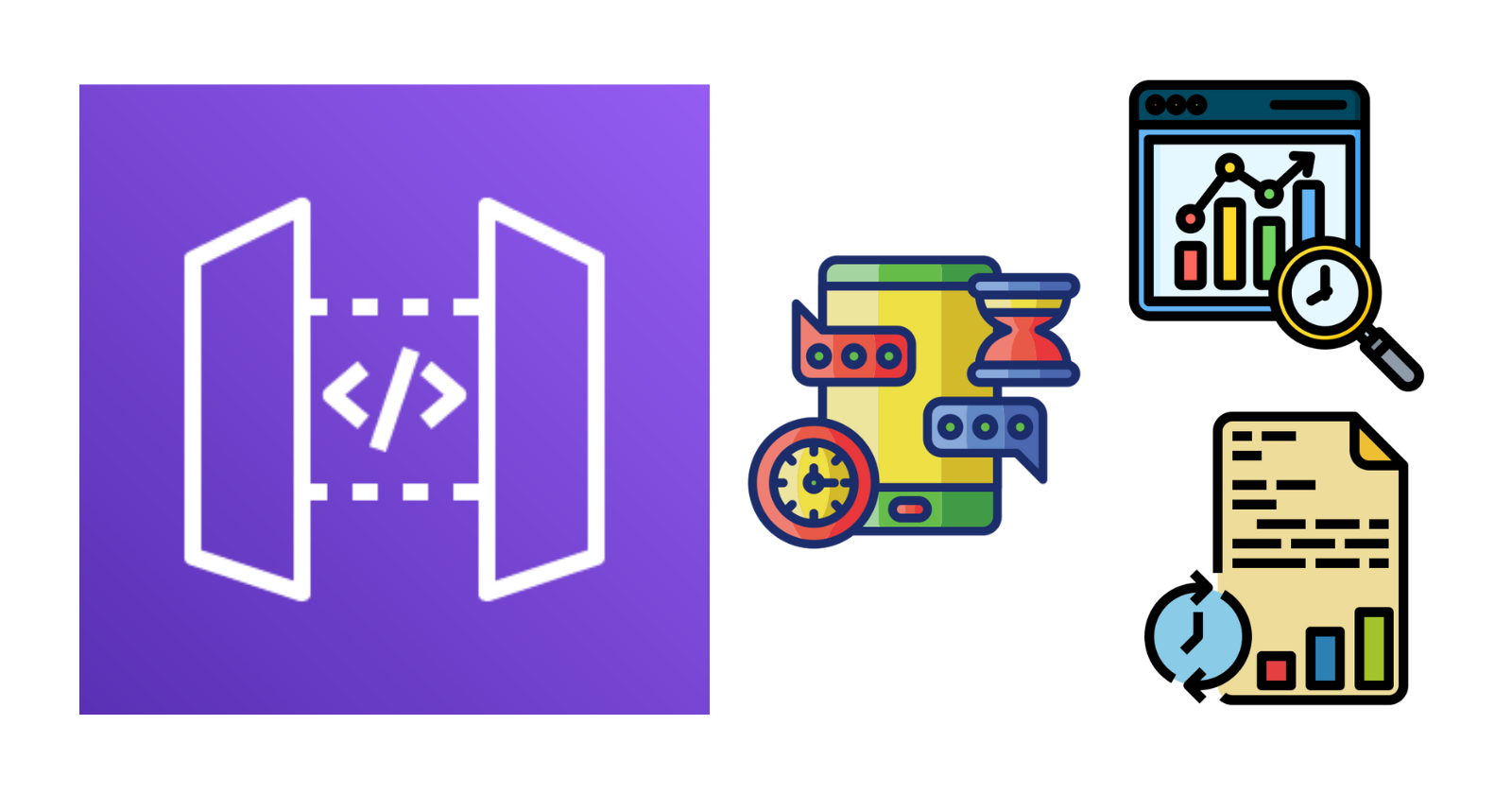How to Use WebSockets with Amazon API Gateway
 Raul Naupari
Raul Naupari
WebSockets is a communication protocol that enables full-duplex data exchange over a single TCP connection, facilitating real-time interactions between clients and servers. Amazon API Gateway supports this protocol through the WebSockets API, relieving us of the responsibility to manage the connection between the client and the server.
A WebSocket API consists of one or more routes, each defining how a message is processed and integrated with a backend service, typically a Lambda function. Each route has a key that must match the result of the selection expression when a message is received to determine its usage. This selection expression specifies a JSON property expected in the message, and usually looks like $request.body.{path_to_body_element}. By default, three routes are provided:
$connect: Triggered when a connection between the client and the WebSocket API is initiated. Once connected, a unique connection ID is assigned to the client and included in every request to the backend service. This connection ID can be used to send messages back to clients using an endpoint provided by Amazon API Gateway.$disconnect: Triggered when the client disconnects from the WebSocket API.$default: Used when no matching route is found.
In addition to these routes, custom routes can be defined using a key and integration of your choice. To better understand these concepts, let's build a basic chat application, similar to what we have already done in:
Pre-requisites
Have an IAM User with programmatic access.
Install the Amazon Lambda Templates (
dotnet new -i Amazon.Lambda.Templates)Install the Amazon Lambda Tools (
dotnet tool install -g Amazon.Lambda.Tools)Install AWS SAM CLI.
The Backend Services
Run the following commands to set up our Lambda functions:
dotnet new lambda.EmptyFunction -n MyLambda -o .
dotnet add src/MyLambda package Amazon.ApiGatewayManagementApi
dotnet add src/MyLambda package AWSSDK.DynamoDBv2
dotnet add src/MyLambda package Amazon.Lambda.APIGatewayEvents
dotnet new sln -n MyChatApp
dotnet sln add --in-root src/MyLambda
Open the Program.cs file and update the content as follows:
using Amazon.ApiGatewayManagementApi;
using Amazon.ApiGatewayManagementApi.Model;
using Amazon.DynamoDBv2;
using Amazon.DynamoDBv2.Model;
using Amazon.Lambda.APIGatewayEvents;
using Amazon.Lambda.Core;
using System.Text;
using System.Text.Json;
[assembly: LambdaSerializer(typeof(Amazon.Lambda.Serialization.SystemTextJson.DefaultLambdaJsonSerializer))]
namespace MyLambda;
public class Function
{
private AmazonDynamoDBClient _amazonDynamoDB;
private string _table;
public record Payload(string Message);
private readonly JsonSerializerOptions _options;
public Function()
{
_amazonDynamoDB = new AmazonDynamoDBClient();
_table = "connections";
_options = new JsonSerializerOptions()
{
PropertyNamingPolicy = JsonNamingPolicy.CamelCase,
};
}
public async Task<APIGatewayProxyResponse> Connect(APIGatewayProxyRequest input, ILambdaContext context)
{
var putItemRequest = new PutItemRequest
{
TableName = _table,
Item = new Dictionary<string, AttributeValue>
{
{ "connectionid", new AttributeValue { S = input.RequestContext.ConnectionId } }
}
};
await _amazonDynamoDB.PutItemAsync(putItemRequest);
return new APIGatewayProxyResponse
{
Body = "connected",
StatusCode = 200,
Headers = new Dictionary<string, string> { { "Content-Type", "application/json" } }
};
}
public async Task<APIGatewayProxyResponse> Disconnect(APIGatewayProxyRequest input, ILambdaContext context)
{
var deleteItemRequest = new DeleteItemRequest
{
TableName = _table,
Key = new Dictionary<string, AttributeValue>
{
{ "connectionid", new AttributeValue { S = input.RequestContext.ConnectionId } }
}
};
await _amazonDynamoDB.DeleteItemAsync(deleteItemRequest);
return new APIGatewayProxyResponse
{
Body = "disconnected",
StatusCode = 200,
Headers = new Dictionary<string, string> { { "Content-Type", "application/json" } }
};
}
public async Task<APIGatewayProxyResponse> Send(APIGatewayProxyRequest input, ILambdaContext context)
{
var scanRequest = new ScanRequest
{
TableName = _table,
};
var scanResponse = await _amazonDynamoDB.ScanAsync(scanRequest);
var apiClient = new AmazonApiGatewayManagementApiClient(new AmazonApiGatewayManagementApiConfig
{
ServiceURL = $"https://{input.RequestContext.DomainName}/{input.RequestContext.Stage}"
});
var payload = JsonSerializer.Deserialize<Payload>(input.Body, _options)!;
var message = Encoding.UTF8.GetBytes($"{input.RequestContext.ConnectionId} says {payload.Message}");
foreach (var item in scanResponse.Items)
{
var connectionId = item["connectionid"].S;
var postMessageRequest = new PostToConnectionRequest
{
ConnectionId = connectionId,
Data = new MemoryStream(message)
};
try
{
await apiClient.PostToConnectionAsync(postMessageRequest);
}
catch (GoneException)
{
var deleteItemRequest = new DeleteItemRequest
{
TableName = _table,
Key = new Dictionary<string, AttributeValue>
{
{ "connectionid", new AttributeValue { S = input.RequestContext.ConnectionId }}
}
};
await _amazonDynamoDB.DeleteItemAsync(deleteItemRequest);
}
}
return new APIGatewayProxyResponse
{
Body = "message sent",
StatusCode = 200,
Headers = new Dictionary<string, string> { { "Content-Type", "application/json" } }
};
}
}
We are defining the following methods:
Connect: This method saves the connection ID in theconnectionsDynamoDB table.Disconnect: This method deletes the connection ID from theconnectionsDynamoDB table.Send:This method lists all the connection IDs and broadcasts the incoming message to each one.
AWS SAM template
At the solution level, create a template.yml file with the following content:
AWSTemplateFormatVersion: '2010-09-09'
Transform: AWS::Serverless-2016-10-31
Description: >
SAM
Resources:
ConnectionsTable:
Type: AWS::Serverless::SimpleTable
Properties:
PrimaryKey:
Name: connectionid
Type: String
TableName: connections
ChatApi:
Type: AWS::ApiGatewayV2::Api
Properties:
Name: MyChatApp
ProtocolType: WEBSOCKET
RouteSelectionExpression: "$request.body.action"
ConnectFunction:
Type: AWS::Serverless::Function
Properties:
Timeout: 60
MemorySize: 512
Tracing: Active
Runtime: dotnet8
Architectures:
- x86_64
Handler: MyLambda::MyLambda.Function::Connect
CodeUri: ./src/MyLambda/
Policies:
- Statement:
- Effect: Allow
Action:
- 'dynamodb:PutItem'
Resource:
- !Sub 'arn:${AWS::Partition}:dynamodb:${AWS::Region}:${AWS::AccountId}:table/${ConnectionsTable}'
ConnectRoute:
Type: AWS::ApiGatewayV2::Route
Properties:
ApiId: !Ref ChatApi
RouteKey: $connect
AuthorizationType: NONE
OperationName: Connect Route
Target: !Sub "integrations/${ConnectIntegration}"
ConnectIntegration:
Type: AWS::ApiGatewayV2::Integration
Properties:
ApiId: !Ref ChatApi
Description: Connect Integration
IntegrationType: AWS_PROXY
IntegrationUri: !Sub "arn:aws:apigateway:${AWS::Region}:lambda:path/2015-03-31/functions/${ConnectFunction.Arn}/invocations"
ConnectFunctionPermission:
Type: AWS::Lambda::Permission
DependsOn:
- ChatApi
Properties:
Action: lambda:InvokeFunction
FunctionName: !Ref ConnectFunction
Principal: apigateway.amazonaws.com
DisconnectFunction:
Type: AWS::Serverless::Function
Properties:
Timeout: 60
MemorySize: 512
Tracing: Active
Runtime: dotnet8
Architectures:
- x86_64
Handler: MyLambda::MyLambda.Function::Disconnect
CodeUri: ./src/MyLambda/
Policies:
- Statement:
- Effect: Allow
Action:
- 'dynamodb:DeleteItem'
Resource:
- !Sub 'arn:${AWS::Partition}:dynamodb:${AWS::Region}:${AWS::AccountId}:table/${ConnectionsTable}'
DisconnectRoute:
Type: AWS::ApiGatewayV2::Route
Properties:
ApiId: !Ref ChatApi
RouteKey: $disconnect
AuthorizationType: NONE
OperationName: Disconnect Route
Target: !Sub "integrations/${DisconnectIntegration}"
DisconnectIntegration:
Type: AWS::ApiGatewayV2::Integration
Properties:
ApiId: !Ref ChatApi
Description: Disconnect Integration
IntegrationType: AWS_PROXY
IntegrationUri: !Sub "arn:aws:apigateway:${AWS::Region}:lambda:path/2015-03-31/functions/${DisconnectFunction.Arn}/invocations"
DisconnectFunctionPermission:
Type: AWS::Lambda::Permission
DependsOn:
- ChatApi
Properties:
Action: lambda:InvokeFunction
FunctionName: !Ref DisconnectFunction
Principal: apigateway.amazonaws.com
SendFunction:
Type: AWS::Serverless::Function
Properties:
Timeout: 60
MemorySize: 512
Tracing: Active
Runtime: dotnet8
Architectures:
- x86_64
Handler: MyLambda::MyLambda.Function::Send
CodeUri: ./src/MyLambda/
Policies:
- Statement:
- Effect: Allow
Action:
- 'dynamodb:Scan'
Resource:
- !Sub 'arn:${AWS::Partition}:dynamodb:${AWS::Region}:${AWS::AccountId}:table/${ConnectionsTable}'
- Effect: Allow
Action:
- 'execute-api:ManageConnections'
Resource:
- !Sub 'arn:aws:execute-api:${AWS::Region}:${AWS::AccountId}:${ChatApi}/*'
SendRoute:
Type: AWS::ApiGatewayV2::Route
Properties:
ApiId: !Ref ChatApi
RouteKey: send
AuthorizationType: NONE
OperationName: Send Route
Target: !Sub "integrations/${SendIntegration}"
SendIntegration:
Type: AWS::ApiGatewayV2::Integration
Properties:
ApiId: !Ref ChatApi
Description: Send Integration
IntegrationType: AWS_PROXY
IntegrationUri: !Sub "arn:aws:apigateway:${AWS::Region}:lambda:path/2015-03-31/functions/${SendFunction.Arn}/invocations"
SendFunctionPermission:
Type: AWS::Lambda::Permission
DependsOn:
- ChatApi
Properties:
Action: lambda:InvokeFunction
FunctionName: !Ref SendFunction
Principal: apigateway.amazonaws.com
Deployment:
Type: AWS::ApiGatewayV2::Deployment
DependsOn:
- ConnectRoute
- DisconnectRoute
- SendRoute
Properties:
ApiId: !Ref ChatApi
Stage:
Type: AWS::ApiGatewayV2::Stage
Properties:
StageName: prod
Description: prod stage
DeploymentId: !Ref Deployment
ApiId: !Ref ChatApi
AutoDeploy: true
Outputs:
WebSocketURI:
Description: "The WSS protocol URI to connect to"
Value: !Sub wss://${ChatApi}.execute-api.${AWS::Region}.amazonaws.com/${Stage}
In the script above, we define a DynamoDB table using the AWS::Serverless::SimpleTable resource and the WebSocket API through the AWS::ApiGatewayV2::Api resource. For each route - $connect, $disconnect, and send - we create the following resources:
AWS::Serverless::Function: Creates the Lambda function with the necessary permissions.AWS::Lambda::Permission: Grants permission for Amazon API Gateway to invoke the Lambda function.AWS::ApiGatewayV2::Route: Creates a route with a specificRouteKey.AWS::ApiGatewayV2::Integration: Creates the connection between the route and the Lambda function.
Finally, the AWS::ApiGatewayV2::Deployment and AWS::ApiGatewayV2::Stage resources complete the setup for our application environment. Run the following commands to deploy the resources to AWS:
sam build
sam deploy --guided
The Client
Create a client.html file at the solution level with the following content:
<!DOCTYPE html>
<html>
<head>
<meta charset="utf-8">
<title>Chat</title>
</head>
<body>
<input id="message" placeholder="Message" />
<button id="send" type="button">Send</button>
<hr />
<ul id="messages"></ul>
<script>
document.addEventListener("DOMContentLoaded", () => {
const websocket = new WebSocket("[WebSocketURI]");
websocket.onmessage = (e) => {
const li = document.createElement("li");
li.textContent = `${e.data}`;
document.getElementById("messages").appendChild(li);
};
document.getElementById("send").addEventListener("click", async () => {
const message = document.getElementById("message").value;
const payload = { action: "send", message: message };
try {
await websocket.send(JSON.stringify(payload));
} catch (err) {
console.error(err);
}
});
});
</script>
</body>
</html>
The script above starts the WebSocket and sets up a handler to receive messages from the server. It also sets up a handler for the button to send messages to the server. You can find all the code here. Thanks, and happy coding.
Subscribe to my newsletter
Read articles from Raul Naupari directly inside your inbox. Subscribe to the newsletter, and don't miss out.
Written by

Raul Naupari
Raul Naupari
Somebody who likes to code